VOICE OF FLAME
From Heirloom to Wardrobes - Understanding the Journey of Bhujodi Weavers - Kutch, Gujarat | Discover India Program
19 Jun 2024 | Author: Arha Shah |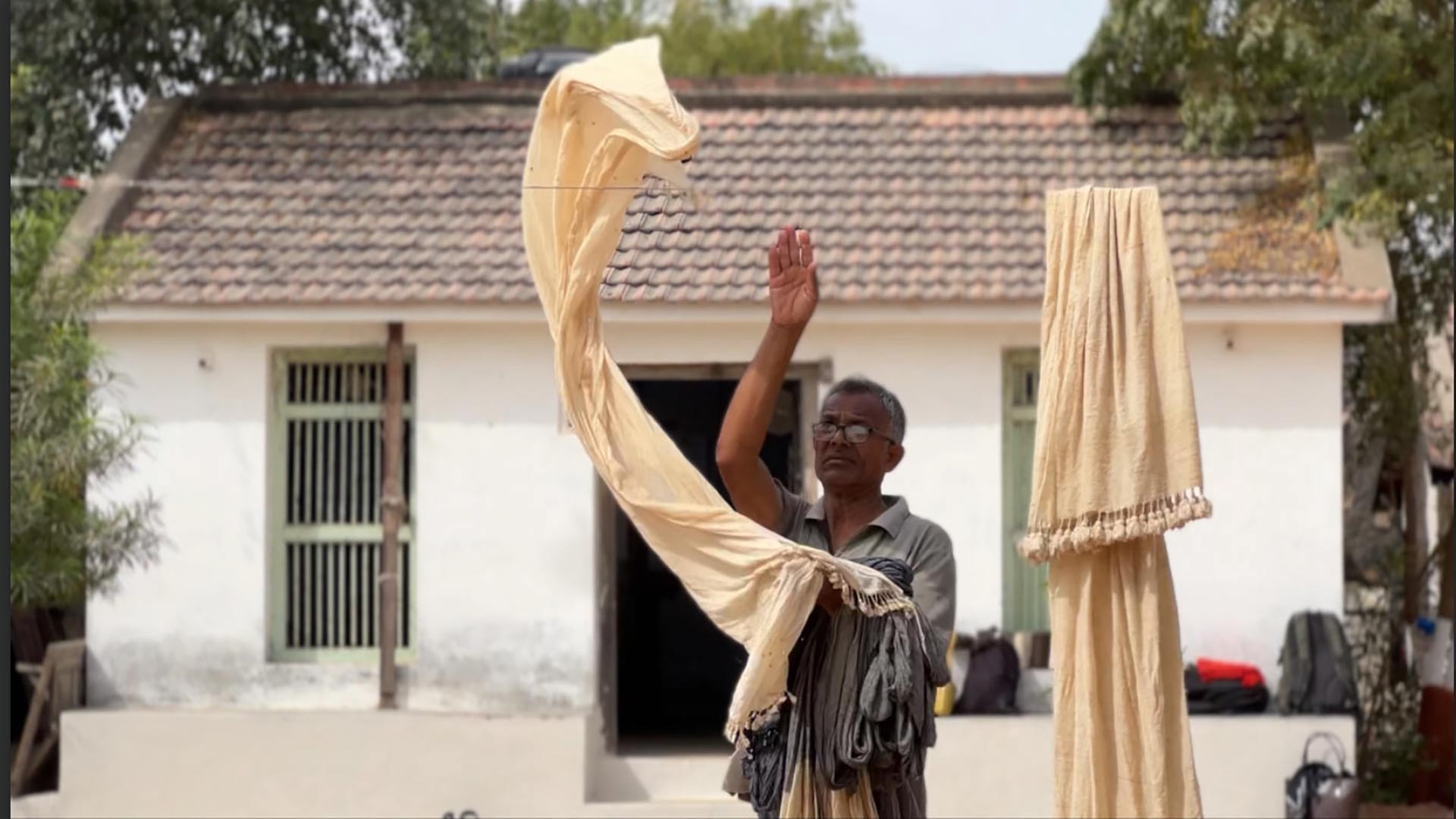

From Heirloom to Wardrobes - Understanding the Journey of Bhujodi Weavers - Kutch, Gujarat | Discover India Program
કચ્છના રણમાં, જ્યાં કલા જીવન છે અને જીવન એ જ કલા
Kutchh na ranma, jya kala jivan che ane jivan aj kala
In the Rann of Kutch, where art is life and life is an art
IDEATION
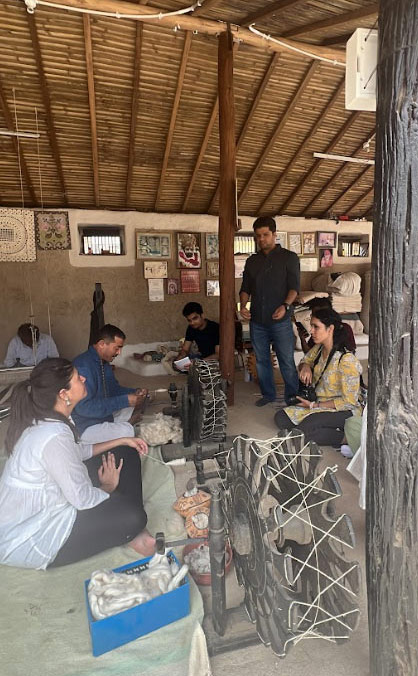
"Great things never came from comfort zones." With this belief, my team and I embarked on a journey to explore potential places and arts for the Discover India Program (DIP), focusing on textiles and handloom. Initially, names like Kanjivaram, Banarasi, or Paithani dominated our thoughts. However, we soon uncovered the hidden gem of Bhujodi, nestled in the vibrant expanse of Kutch, and realized it does not receive the recognition it deserves. While Gujarat is celebrated for Bandhani, Bhujodi is another handloom treasure that warrants global acclaim.
Thus, Bhujodi became our chosen subject for research. We delved into extensive literature reviews and secondary research before venturing into the field. Immersing ourselves in their culture and way of life was a treat beyond compare. The weavers of Bhujodi welcomed us with their hospitality as warm as the intricate threads they weave. Throughout the course of a week, we had the opportunity to engage with over 100 weavers, each of whom provided us with a distinct and enriching experience. They shared with us the significance of their craft, stories from their past, and how it contributes to their overall mental and physical well-being. The article that follows details our observations and encounters with the Vankars of Bhujodi.
INTRODUCTION
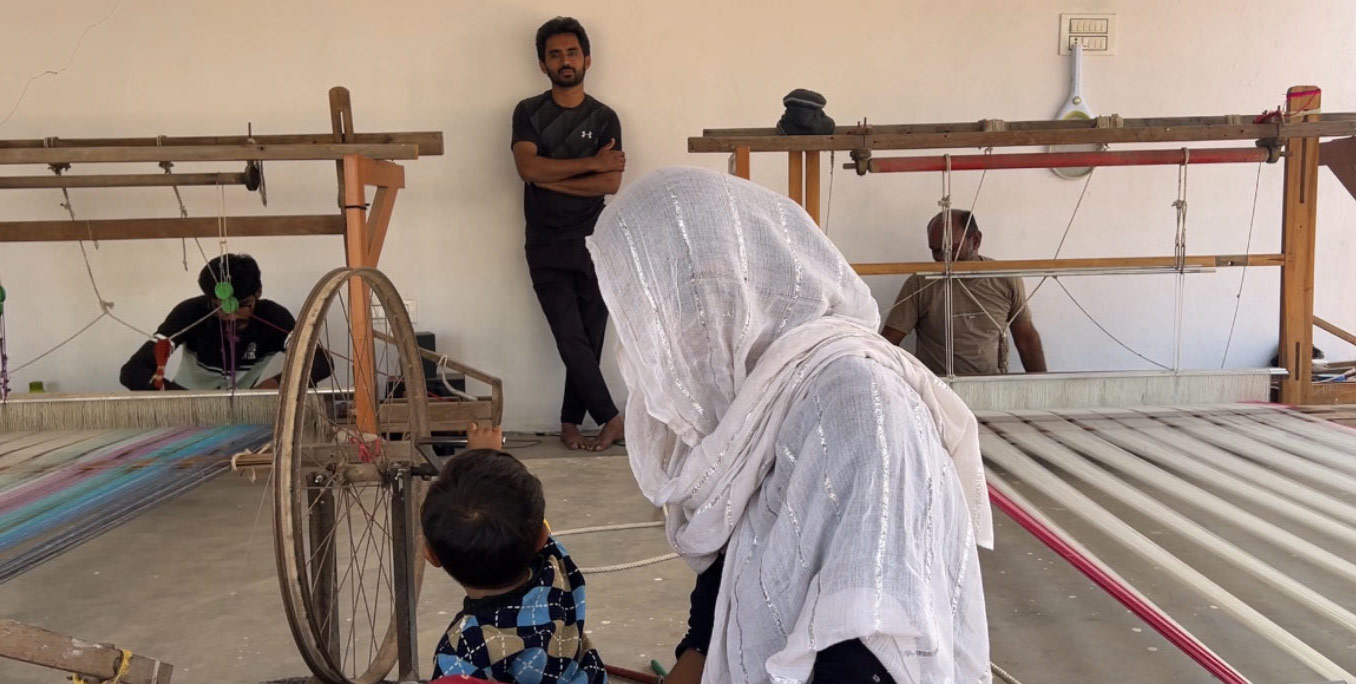
In the heart of Bhujodi, amidst the vibrant threads of tradition, lies a community deeply rooted in the artistry of weaving, where every strand tells a story of generations of resilience, perseverance, and boundless joy. Welcome to a world where heritage is not merely preserved but passionately nurtured by hands that weave dreams into reality, each thread a testament to the enduring spirit of people who find profound happiness in honoring their heritage.
ORIGIN AND BACKGROUND
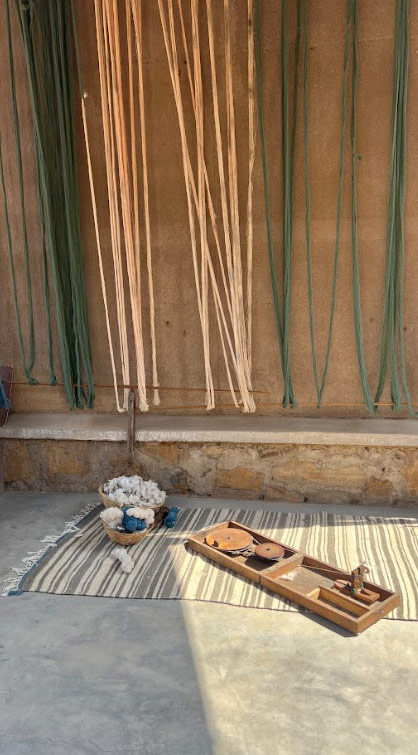
Originating from a symbiotic relationship centuries ago, the Rabaris, a nomadic cattle-herding community from Rajasthan, migrated to Kutch. They needed warm clothing to protect themselves from the chilly weather, so the solution came in the form of a mutually beneficial arrangement with the Bhujodi weavers, aka Vankars. The wool extracted from their cattle was given to the weavers. They provided raw materials, and in return, the Bhujodis crafted dhablas and blankets. The tribes then embroidered exquisite and unique patterns on the woven material to symbolize their community. The ancient trade with the Rabaris gradually waned over time, compelling the weavers to adapt to new market demands and climatic conditions. They began catering to the local population of Kutch, modifying their materials and products to suit the warmer climate. This shift saw the emergence of sarees and shawls as the weavers' primary offerings, skillfully crafted to meet the needs and tastes of their local clientele.
During an interview, Prakash Bhai Vankar (a weaver we interviewed during the project) reflected, "In the past, clothing served a greater purpose than just providing protection; it was a primary means of identification. We didn't need to ask each other where we were going, where we came from, which community we belonged to, or even our age. All of this was communicated through the clothes we wore. Clothing symbolized every community and conveyed their background. This differentiation was achieved through various weaving patterns, the use of different colors, distinct styles, and unique adornments."
NEW IDENTITY FOR THE WEAVERS

Over the generations, what began as a survival skill evolved into a craft seeking growth and recognition beyond the local market. Today, the weaves of Bhujodi are not just celebrated across India but have also captivated an international audience. Their unique patterns, quality of materials, and the personal stories of the artisans behind each piece have garnered the attention of global brands and fashion designers. Well-known companies like FabIndia and renowned designers such as Anita Dongre now engage in long-term partnerships with these artisans, ensuring that the legacy of Bhujodi weaving not only endures but thrives in the modern era.
The presence of Bhujodi's weavers has expanded significantly, with a strong foothold in both offline and online markets. This expansion has been fueled by a commitment to innovation while steadfastly preserving the essence of their craft. The global recognition of Bhujodi weaving is a testament to the dedication of its weavers, bridging traditional craftsmanship with contemporary appeal and showcasing it to the world.
WEAVING: A WAY OF LIFE, NOT JUST LIVELIHOOD
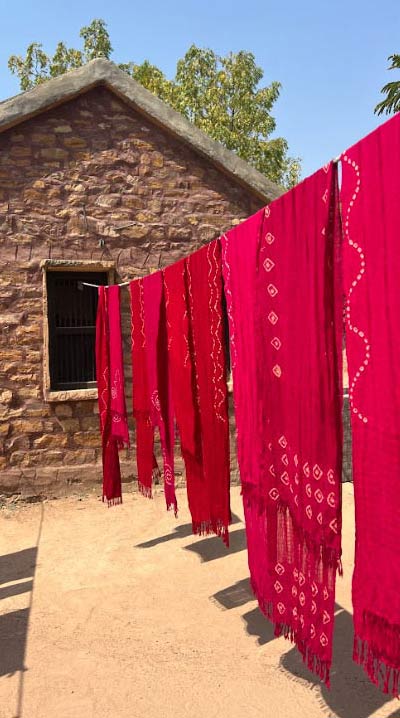
Weaving here means more than just a source of livelihood; it is, as they call it, their ‘way of life’ or their “parampara” (tradition). This craft is introduced to children not just as a skill but as an integral part of their lives and heritage. Weaving is an art ingrained in children as young as five; much like the natural acquisition of languages, the clacking of looms is not just background noise but a call to their future. Tools of trade become their toys, familiarizing them with the craft. They are often found by their parents' sides on the loom, watching intently and absorbing the movements through keen observation.
As they grow, the mysteries of the loom unfold before them. They are taught the nuances of weaving, the tales that explain patterns derived from long ago, and the colors that signify their culture. Around the age of 13, their hands finally grace the loom, weaving basic patterns and creating simple pieces like table mats. This marks the beginning of their journey in earnest, as they refine their skills on looms adapted for learning, threading their way through discoveries.
Reaching the age of 18 is a rite of passage in this community; 18 is when they are entrusted with their first fully functional loom. This is not just a tool; it is a canvas for their creativity, a source of pride, and a continuation of their legacy. They are now weavers in their own right, ready to add their chapters to the ongoing story of Bhujodi’s weaving tradition, crafting exquisite pieces that exude artistry and excellence.
In the tranquil sanctum of their homes, the weavers of Bhujodi find solace in the clinking of their looms, a routine that transcends mere labor to become a symphony of familial unity.
Amidst the verdant embrace of their backyards, generations converge to breathe life into threads of tradition, every member taking an essential note in the melody of creation with immense respect for each other.
THE PROCESS
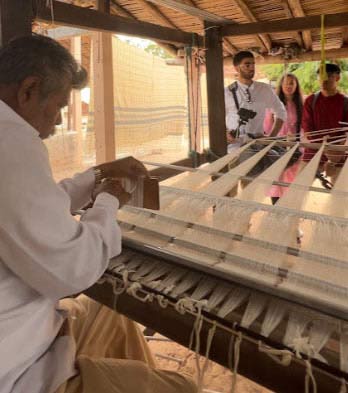
The journey of creation begins with sourcing materials, with cotton, wool, and silk sourced mainly from Ludhiana and other parts of Gujarat. These raw materials undergo meticulous processing, from combing and carding to spinning into yarn using the charkha. The dyeing process is a spectacle in itself, with natural dyes like rhubarb, babool, acai tree, lac, turmeric, beet, and onion peels infusing each thread with rich hues of convention. Only indigo stands as a reminder of modernity, dyed chemically for its distinctive shade.
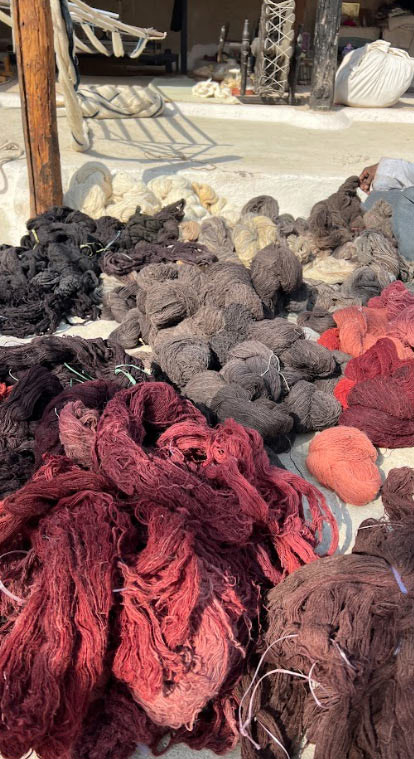
Once the materials are prepared, the meticulous craftsmanship continues with the creation of spindles and bobbins, meticulously harped on racks awaiting the handloom. The rhythmic clatter of the loom sets the stage for the weaving process, with each movement a testament to generations of skill and expertise.
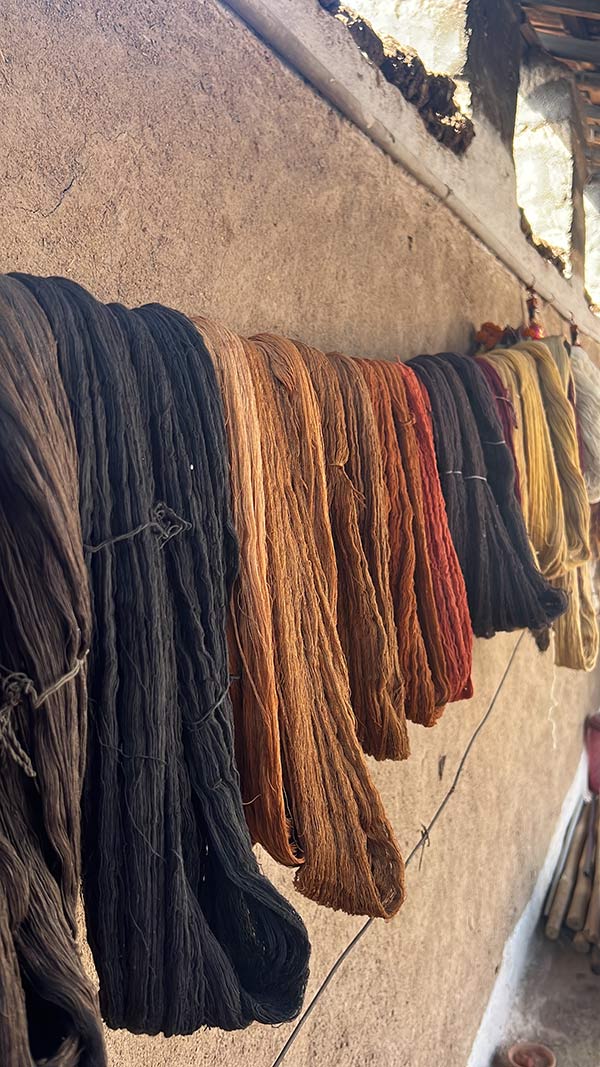
But the journey doesn't end there. Finishing touches are meticulously applied, ensuring each piece meets the exacting standards of quality and craftsmanship. The finished products find their way to eager customers through various avenues, from humble home storefronts to bustling village shops. They also attract attention from renowned brands, showcasing the artisans' talents on a global stage. With a strong online presence and participation in prestigious exhibitions like the Rann Utsav (a popular tourism event) and government-hosted exhibitions across India, these artisans continue to weave masterpieces.
Inspired by the surrounding environment, the motifs and patterns adorning each fabric narrate a tale of reverence for nature and the world around them. With meticulous attention to detail, every piece becomes a testament to the values of mindfulness, craftsmanship, and authenticity. Unlike mass-produced garments that may lack soul, these handcrafted treasures bear an inherent sense of worth and longevity.
POLICY ASPECT
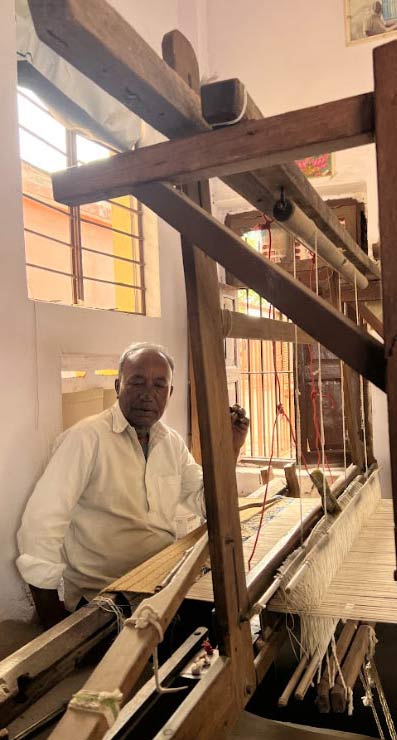
According to Arjun Bhai (another weaver we interviewed during the project), the Ministry of Textile Department convenes regular Focus Group Discussions (FGDs) and meetings with karigars across India, bringing together key stakeholders to deliberate on ongoing schemes and projects aimed at strengthening the welfare of weavers. These sessions serve as vital forums for soliciting feedback, enabling the government to adapt and refine its initiatives in response to the needs of the handloom weavers, thus fostering an environment conducive to its growth.
Furthermore, the government organizes numerous fairs and exhibitions nationwide at different intervals throughout the year. Upon verification of their work, artisans are issued identity cards ("pehchan cards") and offered stalls at subsidized or nominal rates, facilitating access to a wider audience. This concerted effort has not only expanded the reach of their products on a national scale but has also garnered significant international attention, particularly from the US, Canada, and the UK. Notably, Japanese interest in Indian handwoven fabrics, predominantly from Kutch, has increased over the last 15 years, leading to the establishment of ‘The Calico Store’ in Japan, a testament to the collaborative endeavors between the artisans and foreign citizens.
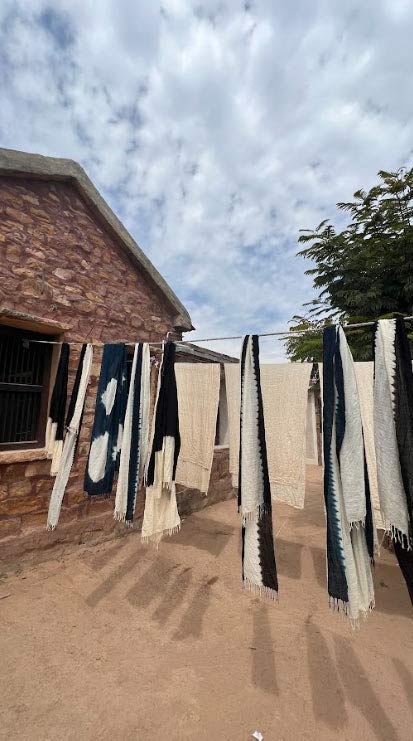
In recognition of exemplary craftsmanship, the government has instituted various awards, including the prestigious Rashtrapati Puraskar, the National Master Craftsman's Award, and Sant Kabir awards, which are bestowed upon artisans like Vishram Valji from Bhujodi for exceptional contributions. Bapuji from Bhujodi was given the Prime Minister's Award in 1974 for creating a masterpiece made with the unique extra-weft technique of 75 threads per inch with a total width of 30 inches. The ‘Kutchi’ shawls have also received the ‘GI (Geographical Indication) tag. Till 2012, a host of cheap industrial imitations of the designs were being mass-produced by factories in Ludhiana. This came to an end after the GI was granted, and action was taken in that regard (Deccan Herald)*. These recognitions underscore the government's commitment to honoring and preserving India's rich handloom heritage.
AN INSIGHT INTO THE LANES AND LIVES OF BHUJODI
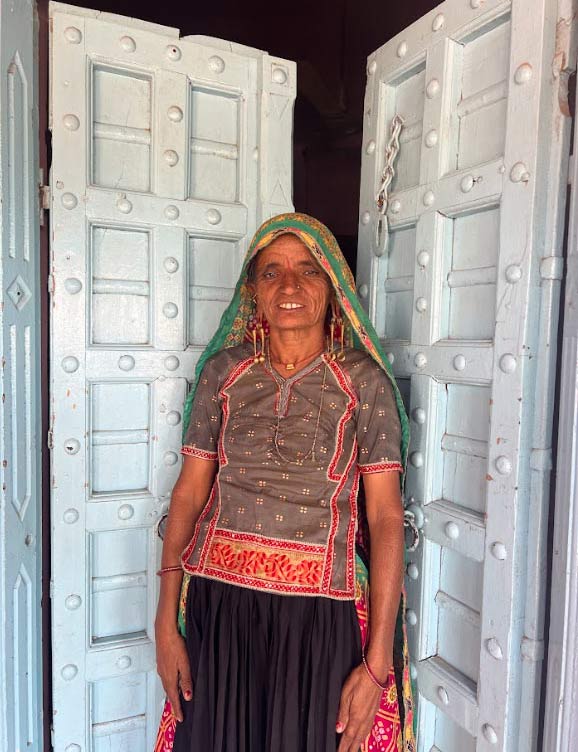
For visitors to Bhujodi, observing the artisans at work is a transformative encounter. They witness firsthand the passion and dedication woven into each thread, fostering a profound connection and admiration for the craft. It's more than a mere transaction; it's a shared odyssey, where the garment transcends mere clothing to become a cherished possession imbued with the spirit of its creators. In a world dominated by fleeting trends and mass production, the enduring allure of Bhujodi's hand-woven creations lies in the authenticity of the experience. It's a celebration of craftsmanship and human connection, where the threads of the past intertwine seamlessly with the fabric of the future.
In this close-knit community of weavers, where tradition weaves its own tale, competition takes a backseat to individuality. Despite over a hundred families engaging in the same craft, there's an unwavering sense of camaraderie and mutual respect. Each family brings its own unique touch to the loom, distinguishing themselves through vibrant color combinations, intricate patterns, and signature styles.
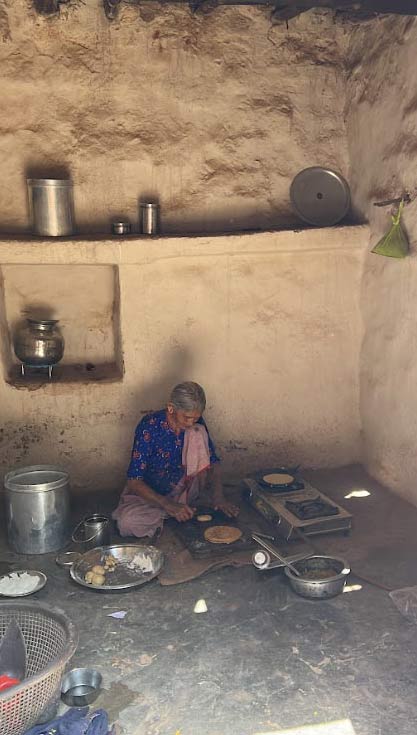
It's not just the artistry that draws them here; it's the sanctuary of home, where the air is pure and untainted by the chaos of the world beyond. Here, amidst the gentle hum of looms, where each individual is revered for their contribution, where one cherishes the autonomy of being their own master, and where the family together savors the simple joys of freshly cooked meals, rotlo, daal, and khichdi, and the warmth of spending every day together, they weave, spend time with people in the neighborhood, and believe in the importance of a good night's sleep because here the days begin as early as around 5 a.m. Every day, they pray, clean their spaces, and very peacefully begin their day. In Bhujodi, time bends to their will, allowing for breaks when the spirit falters and rest when the body fatigues. Amidst a community of kindred spirits, they find a harmonious balance between work and life—a tapestry woven with the love and laughter of a united family.
Remarkably, we encountered individuals who had traversed the globe, honing their skills in prestigious institutions like NIFT, IITs, and Tesla, only to return to the comforting embrace of Bhujodi's looms. Their journeys bore witness to the realization that the pursuit of passion and purpose far outweighed the allure of worldly success. In their quest for innovation and excellence, they found themselves not just artisans but ambassadors of timeless art, pioneering new frontiers in the global marketplace. Despite the temptations of urban allure and the promises of distant dreams, they realized that true fulfillment lies not in the pursuit of material wealth but in the sacred threads that bind them to their ancestry.
In delving into the profound motivations that propel the artisans of Bhujodi to dedicate extensive hours to their craft, one must explore the very core of their existence. It's an intrinsic connection to their craft that surpasses the ordinary. When queried about their remarkable endurance and commitment, their response is both simple and profound: weaving embodies their highest form of meditation, a sacred communion with the self.
Weaving is an act of devotion that demands the entirety of one's being - as they say, “ekaant” (solitude). Each artisan invests their heart, soul, and unyielding concentration into the intricate process, crafting not just fabric but also infusing each thread with their aspirations. Amidst the rhythmic cadence of hands and feet, their minds find solace in solitude, wholly absorbed in the creative endeavor of bringing designs to perfection and precision.
In Bhujodi, we found more than just a town; we witnessed the resilience of a community steadfast in their commitment to preserving the essence of their heritage. As the world hurtles forward in a relentless pursuit of progress, Bhujodi stands as a testament to the enduring power of tradition and the timeless beauty of crafting a life steeped in passion, purpose, and the echoes of generations past.
Team members: Achira Shah, Akshita Garg, Avanthika Khemchand, Daksh Lodha, Deep Shah, Rhythm Kumar, Sanat Kapur, Vrusti Shah, Yash Keyal, Yojit Ojha, and Yugank Gupta
(Author: Arha Shah, Undergraduate Student)






